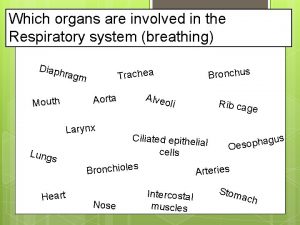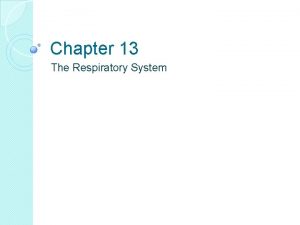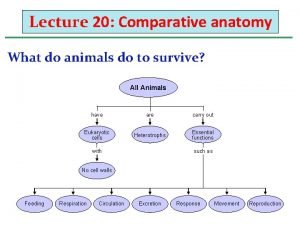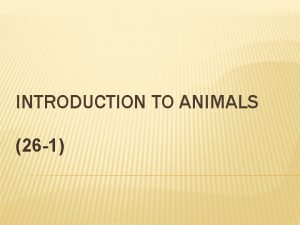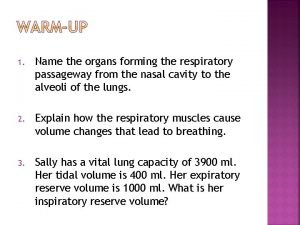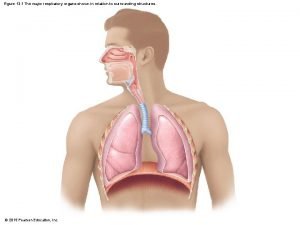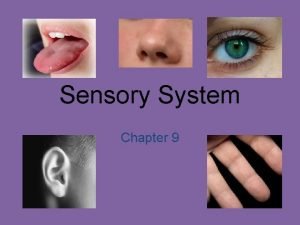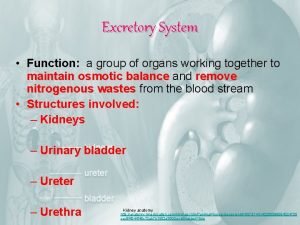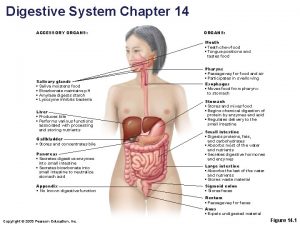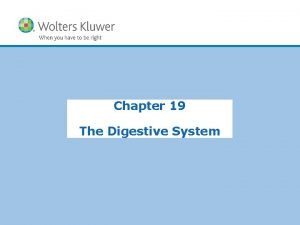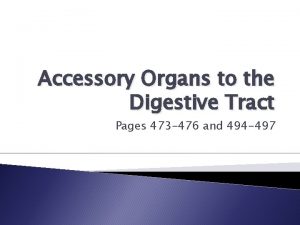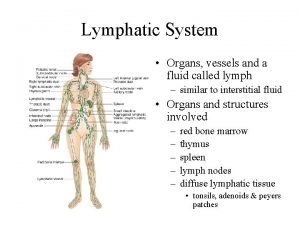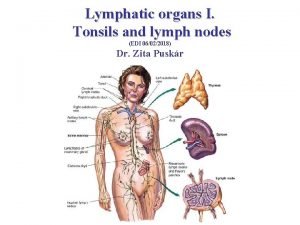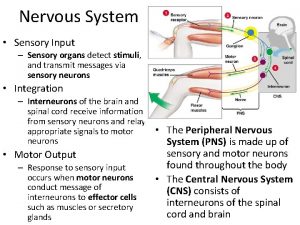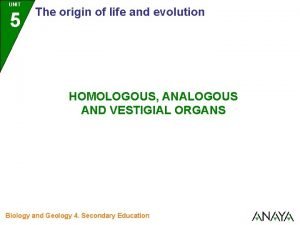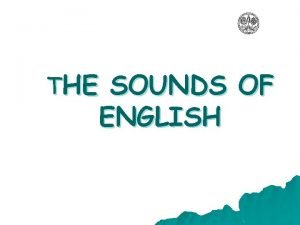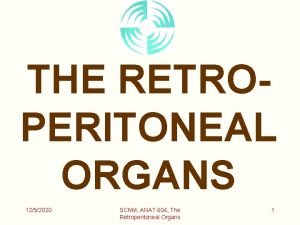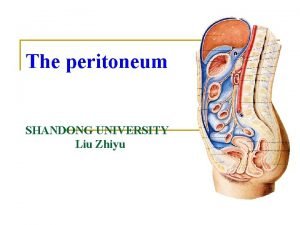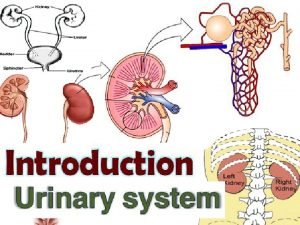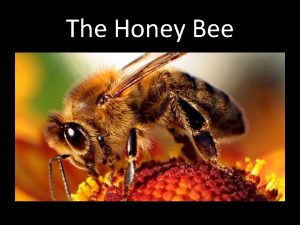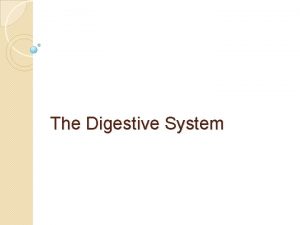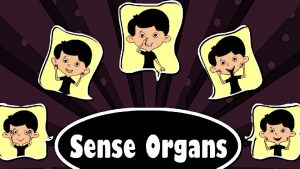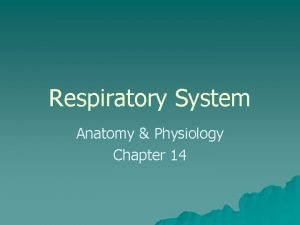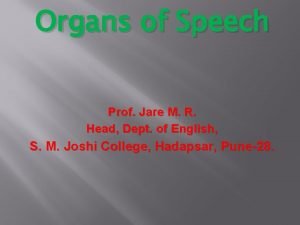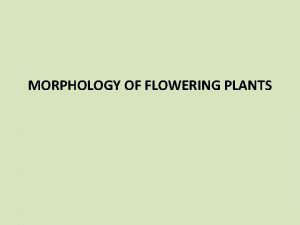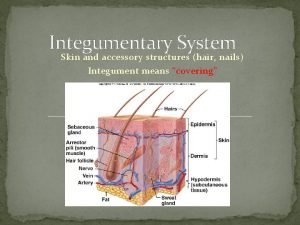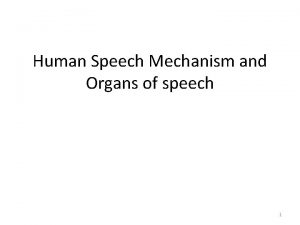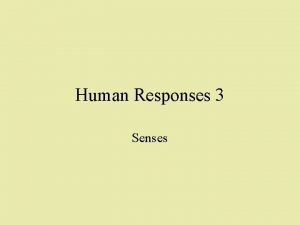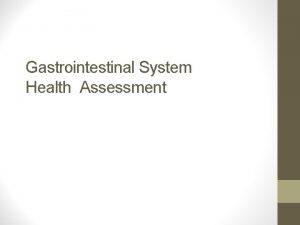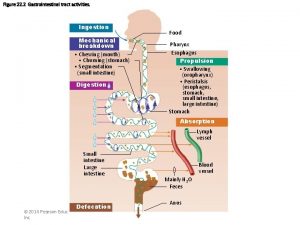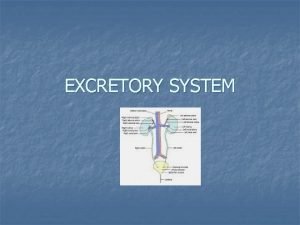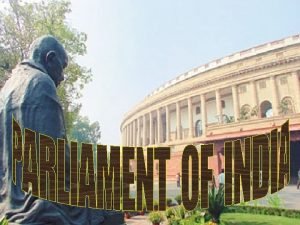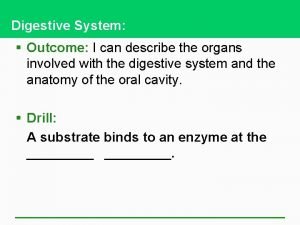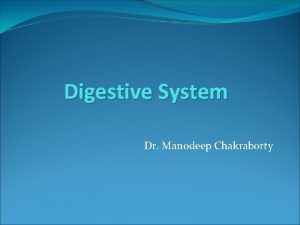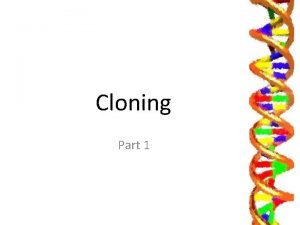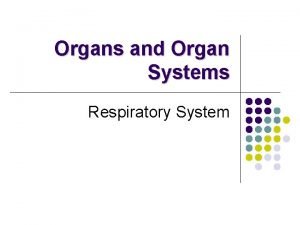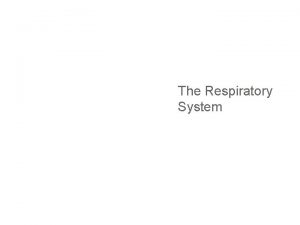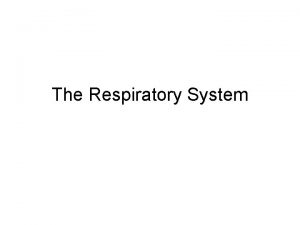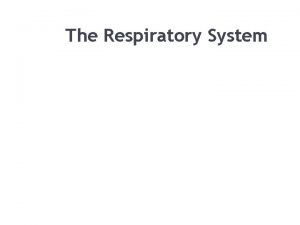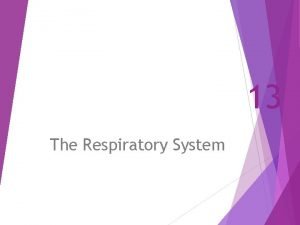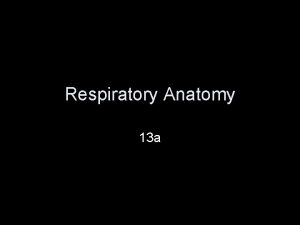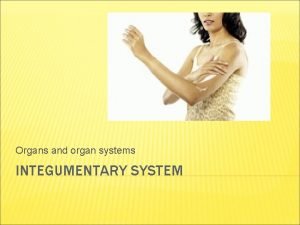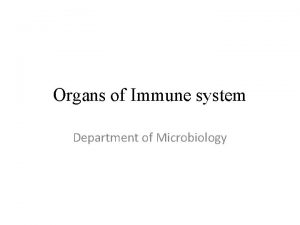The Respiratory System Organs of the Respiratory system
























































- Slides: 56

The Respiratory System

Organs of the Respiratory system • • • Nose Pharynx Larynx Trachea Bronchi Lungs – alveoli Figure 13. 1

Function of the Respiratory System • Oversees gas exchanges between the blood and external environment • Exchange of gasses takes place within the alveoli • Passageways to the lungs purify, warm, and humidify the incoming air

The Nose • The only externally visible part of the respiratory system • Air enters the nose through the external nares (nostrils) • The interior of the nose consists of a nasal cavity divided by a nasal septum

Upper Respiratory Tract Figure 13. 2

Anatomy of the Nasal Cavity • Olfactory receptors are located in the mucosa on the superior surface • The rest of the cavity is lined with respiratory mucosa – Moistens air – Traps incoming foreign particles

Anatomy of the Nasal Cavity • Lateral walls have projections called conchae – Increases surface area – Increases air turbulence within the nasal cavity • The nasal cavity is separated from the oral cavity by the palate – Anterior hard palate (bone) – Posterior soft palate (muscle)

Paranasal Sinuses • Cavities within bones surrounding the nasal cavity – Frontal bone – Sphenoid bone – Ethmoid bone – Maxillary bone

Paranasal Sinuses • Function of the sinuses – Lighten the skull – Act as resonance chambers for speech – Produce mucus that drains into the nasal cavity

Pharynx (Throat) • Muscular passage from nasal cavity to larynx • Three regions of the pharynx – Nasopharynx – superior region behind nasal cavity – Oropharynx – middle region behind mouth – Laryngopharynx – inferior region attached to larynx • The oropharynx and laryngopharynx are common passageways for air and food

Structures of the Pharynx • Auditory tubes enter the nasopharynx • Tonsils of the pharynx – Pharyngeal tonsil (adenoids) in the nasopharynx – Palatine tonsils in the oropharynx – Lingual tonsils at the base of the tongue

Larynx (Voice Box) • Routes air and food into proper channels • Plays a role in speech • Made of eight rigid hyaline cartilages and a spoon-shaped flap of elastic cartilage (epiglottis) • Vocal cords - vibrate with expelled air to create sound (speech)

Structures of the Larynx • Thyroid cartilage – Largest hyaline cartilage – Protrudes anteriorly (Adam’s apple) • Epiglottis – Superior opening of the larynx – Routes food to the larynx and air toward the trachea • Glottis – opening between vocal cords

Trachea (Windpipe) • Connects larynx with bronchi • Lined with ciliated mucosa – Beat continuously in the opposite direction of incoming air – Expel mucus loaded with dust and other debris away from lungs • Walls are reinforced with C-shaped hyaline cartilage

Primary Bronchi • Formed by division of the trachea • Enters the lung at the hilus (medial depression) • Right bronchus is wider, shorter, and straighter than left • Bronchi subdivide into smaller and smaller branches

Lungs • Ocupy most of the thoracic cavity – Apex is near the clavicle (superior portion) – Each lung is divided into lobes by fissures • Left lung – two lobes • Right lung – three lobes

Lungs Figure 13. 4 b

Coverings of the Lungs • Pulmonary (visceral) pleura covers the lung surface • Parietal pleura lines the walls of the thoracic cavity • Pleural fluid fills the area between layers of pleura to allow gliding

Respiratory Tree Divisions • • • Primary bronchi Secondary bronchi Tertiary bronchi Bronchioli Terminal bronchioli

Bronchioles • Smallest branches of the bronchi • All but the smallest branches have reinforcing cartilage • Terminal bronchioles end in alveoli Figure 13. 5 a

Respiratory Zone • Structures – Respiratory bronchioli – Alveolar duct – Alveoli • Site of gas exchange

Alveoli • Structure of alveoli – Alveolar duct – Alveolar sac – Alveolus • Gas exchange takes place within the alveoli in the respiratory membrane • Squamous epithelial lining alveolar walls • Covered with pulmonary capillaries on external surfaces

Respiratory Membrane (Air. Blood Barrier) Figure 13. 6

Gas Exchange • Gas crosses the respiratory membrane by diffusion – Oxygen enters the blood – Carbon dioxide enters the alveoli • Macrophages add protection • Surfactant coats gas-exposed alveolar surfaces

Events of Respiration • Pulmonary ventilation – moving air in and out of the lungs • External respiration – gas exchange between pulmonary blood and alveoli

Events of Respiration • Respiratory gas transport – transport of oxygen and carbon dioxide via the bloodstream • Internal respiration – gas exchange between blood and tissue cells in systemic capillaries

Mechanics of Breathing (Pulmonary Ventilation) • Mechanical process • Depends on volume changes in the thoracic cavity • Volume changes lead to pressure changes, which lead to equalize pressure of flow of gases • 2 phases – Inspiration – flow of air into lung – Expiration – air leaving lung

Inspiration • Diaphragm and intercostal muscles contract • The size of the thoracic cavity increases • External air is pulled into the lungs due to an increase in intrapulmonary volume

Expiration • Passive process dependent up on natural lung elasticity • As muscles relax, air is pushed out of the lungs • Forced expiration can occur mostly by contracting internal intercostal muscles to depress the rib cage

Expiration Figure 13. 7 b

Pressure Differences in the Thoracic Cavity • Normal pressure within the pleural space is always negative (intrapleural pressure) • Differences in lung and pleural space pressures keep lungs from collapsing

Nonrespiratory Air Movements • Caused by reflexes or voluntary actions • Examples – Cough and sneeze – clears lungs of debris – Laughing – Crying – Yawn – Hiccup

Respiratory Volumes and Capacities • Normal breathing moves about 500 ml of air with each breath - tidal volume (TV) • Many factors that affect respiratory capacity – – A person’s size Sex Age Physical condition • Residual volume of air – after exhalation, about 1200 ml of air remains in the lungs

Respiratory Volumes and Capacities • Inspiratory reserve volume (IRV) – Amount of air that can be taken in forcibly over the tidal volume – Usually between 2100 and 3200 ml • Expiratory reserve volume (ERV) – Amount of air that can be forcibly exhaled – Approximately 1200 ml • Residual volume – Air remaining in lung after expiration – About 1200 ml

Respiratory Volumes and Capacities • Functional volume – Air that actually reaches the respiratory zone – Usually about 350 ml • Respiratory capacities are measured with a spirometer

Respiratory Sounds • Sounds are monitored with a stethoscope • Bronchial sounds – produced by air rushing through trachea and bronchi • Vesicular breathing sounds – soft sounds of air filling alveoli

External Respiration • Oxygen movement into the blood – The alveoli always has more oxygen than the blood – Oxygen moves by diffusion towards the area of lower concentration – Pulmonary capillary blood gains oxygen

External Respiration • Carbon dioxide movement out of the blood – Blood returning from tissues has higher concentrations of carbon dioxide than air in the alveoli – Pulmonary capillary blood gives up carbon dioxide • Blood leaving the lungs is oxygen-rich and carbon dioxide-poor

Gas Transport in the Blood • Oxygen transport in the blood – Inside red blood cells attached to hemoglobin (oxyhemoglobin [Hb. O 2]) – A small amount is carried dissolved in the plasma • Carbon dioxide transport in the blood – Most is transported in the plasma as bicarbonate ion (HCO 3–) – A small amount is carried inside red blood cells on hemoglobin, but at different binding sites than those of oxygen

Internal Respiration • Exchange of gases between blood and body cells • An opposite reaction to what occurs in the lungs – Carbon dioxide diffuses out of tissue to blood – Oxygen diffuses from blood into tissue

Internal Respiration Figure 13. 11

Neural Regulation of Respiration • Activity of respiratory muscles is transmitted to the brain by the phrenic and intercostal nerves • Neural centers that control rate & depth are located in the medulla • The pons appears to smooth out respiratory rate • Normal respiratory rate (eupnea) is 12– 15 min. • Hypernia is increased respiratory rate often due to extra oxygen needs

Factors Influencing Respiratory Rate and Depth • Physical factors – Increased body temperature – Exercise – Talking – Coughing • Volition (conscious control) • Emotional factors

Factors Influencing Respiratory Rate and Depth • Chemical factors – Carbon dioxide levels • Level of carbon dioxide in the blood is the main regulatory chemical for respiration • Increased carbon dioxide increases respiration • Changes in carbon dioxide act directly on the medulla oblongata

Factors Influencing Respiratory Rate and Depth • Chemical factors (continued) – Oxygen levels • Changes in oxygen concentration in the blood are detected by chemoreceptors in the aorta and carotid artery • Information is sent to the medulla oblongata

Respiratory Disorders: Chronic Obstructive Pulmonary Disease (COPD) • Exemplified by chronic bronchitis and emphysema • Major causes of death and disability in the United States • Features of these diseases – Patients have a history of smoking – Labored breathing (dyspnea) – Coughing and frequent pulmonary infections

Respiratory Disorders: Chronic Obstructive Pulmonary Disease (COPD) • Features of these diseases (cont. ’) – Most victims retain carbon dioxide – Have hypoxic and respiratory acidosis – Those infected will ultimately develop respiratory failure

Emphysema • Alveoli enlarge as adjacent chambers break through • Chronic inflammation promotes lung fibrosis • Airways collapse during expiration • Patients use a large amount of energy to exhale • Over-inflation of the lungs leads to a barrel chest • Cyanosis appears late in the disease

Chronic Bronchitis • Inflammation of the mucosa of the lower respiratory passages • Mucus production increases • Pooled mucus impairs ventilation & gas exchange • Risk of lung infection increases • Pneumonia is common • Hypoxia and cyanosis occur early

Lung Cancer • Accounts for 1/3 of all cancer deaths in the United States • Increased incidence associated with smoking • Three common types – Squamous cell carcinoma – Adenocarcinoma – Small cell carcinoma

Sudden Infant Death syndrome (SIDS) • Healthy infant stops breathing and dies during sleep • Some cases are thought to be a problem of the neural respiratory control center • 1/3 of cases appear to be due to heart rhythm abnormalities

Asthma • Chronic inflammation if the bronchiole passages • Response to irritants with dyspnea, coughing, and wheezing

Developmental Aspects of the Respiratory System • Lungs are filled with fluid in the fetus • Lungs are not fully inflated with air until two weeks after birth • Surfactant that lowers alveolar surface tension is not present until late in fetal development and may not be present in premature babies

Developmental Aspects of the Respiratory System • Important birth defects – Cystic fibrosis – over-secretion of thick mucus clogs the respiratory system – Cleft palate

Aging Effects • • Elasticity of lungs decreases Vital capacity decreases Blood oxygen levels decrease Stimulating effects of carbon dioxide decreases • More risks of respiratory tract infection

Respiratory Rate Changes Throughout Life Respiration rate: • Newborns – 40 to 80 min. • Infants – 30 min. • Age 5 – 25 min. • Adults – 12 to 18 min • Rate often increases with old age
 Which organs are involved in respiratory system
Which organs are involved in respiratory system Chapter 13 respiratory system
Chapter 13 respiratory system Respiratory organs of invertebrates
Respiratory organs of invertebrates Respiratory organs of invertebrates
Respiratory organs of invertebrates Organs forming the respiratory passageway
Organs forming the respiratory passageway Upper and lower airway
Upper and lower airway Figure 13-1
Figure 13-1 Conducting zone vs respiratory zone
Conducting zone vs respiratory zone Digestive system circulatory system and respiratory system
Digestive system circulatory system and respiratory system Sensory system organs
Sensory system organs Describe the human excretory system
Describe the human excretory system Function of the organs in the digestive system
Function of the organs in the digestive system Accessory organs of the digestive system
Accessory organs of the digestive system Digestive accessory organs
Digestive accessory organs Red and white blood cells difference
Red and white blood cells difference Formation of lymph
Formation of lymph Venule
Venule Lymphatic system organs and functions
Lymphatic system organs and functions Organs of the sensory system
Organs of the sensory system Chapter 16 matching questions 6-10
Chapter 16 matching questions 6-10 How respiratory system work with circulatory system
How respiratory system work with circulatory system Circulatory system and respiratory system work together
Circulatory system and respiratory system work together Organs of wto
Organs of wto Vestigial structure biology
Vestigial structure biology 20 vowel sounds with examples
20 vowel sounds with examples Primary and secondary retroperitoneal organs
Primary and secondary retroperitoneal organs Phrenicosplenic
Phrenicosplenic Peritoneum serous membrane
Peritoneum serous membrane Mesocolon
Mesocolon Adh hormone produced by
Adh hormone produced by Pollen basket
Pollen basket Urinary structure
Urinary structure 4 functions of the stomach
4 functions of the stomach Sense organs
Sense organs Organs homolegs
Organs homolegs Soft paired cone shaped organs
Soft paired cone shaped organs Major plant organs
Major plant organs Articulators theatre definition
Articulators theatre definition Phonatory system
Phonatory system A.k.a. little organs.
A.k.a. little organs. Protect bougainvillea from grazing animals
Protect bougainvillea from grazing animals Tonsil histology
Tonsil histology Nails integumentary system
Nails integumentary system Central lymphoid organs
Central lymphoid organs Articulatory organs
Articulatory organs Images of sense organs with names
Images of sense organs with names Horizontal line
Horizontal line Frog dissection lab worksheet middle school
Frog dissection lab worksheet middle school Microscopic anatomy of stomach
Microscopic anatomy of stomach Excretory system def
Excretory system def Vestigial organs
Vestigial organs Name the three organs of the government
Name the three organs of the government Anatomical position examples
Anatomical position examples Internal organs
Internal organs Mylohyoid muscle
Mylohyoid muscle Intestinal structure
Intestinal structure Book about clones used for organs
Book about clones used for organs
